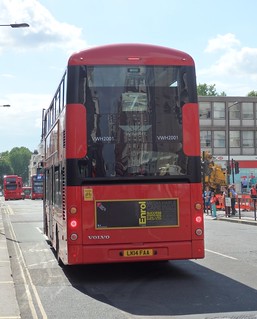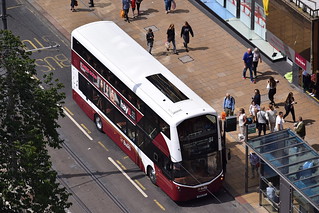This is more of an 'essay' type article because I have some criticisms with the design of the Wrightbus double deck products such as the Gemini 3 and SRM. I have criticised the Wrightbus double deck products in my previous articles and therefore I will lay out my ideas which could possibly inspire the manufacturer to make changes.
One blog user also has criticisms with the Wrightbus SRM design which you can read here.
Talking about the SRM, it was unveiled back in 2016 as the two-door, one-staircase specification of the New Routemaster bus. So far, bus operator RATP-Dev are using six SRM's with Volvo B5LH chassis for their route 183 contract, while Go-Ahead London are using two SRM's with Volvo B5LHC chassis for their route 37 contract.
Since Wrightbus haven't had any new orders for double decker buses with the SRM bodywork, I'm making suggestions on what they need to tweak in order to garner interest from busy companies for their new upcoming purchases. Since Wrightbus unveiled the SRM back in 2016, they still haven't featured the SRM bodywork on the product page of their website, but the three-door two-staircase New Routemaster page is still up.
First Group held a consultation to propose 200 New Routemaster buses for their West Yorkshire services back in 2015. The consultation report showed over 75% of people in West Yorkshire would consider using a bus more often if First’s proposed ‘New Bus’ proposal was introduced.
The Wrightbus SRM would have been a good alternative to the New Routemaster bus for First Bus as they can use two-door or single door for their operations. Instead they continued to purchase conventional buses for their existing and new services. First Group purchased the Wrightbus SRM's competitor, the Enviro400 City for their Bristol (biogas) and Glasgow (diesel) services.
My criticisms
I believe the top rear designs of the Wright Gemini 3 and SRM bodywork should be tweaked, here are some images of the two bus body designs.
Gemini 3
SRM
The SRM has no window on the rear lower deck of the bus; it depends on the chassis which reflects the exterior design of the bus.
In comparison with the Alexander Dennis Enviro400 City bodywork, they lack the lower rear window for their Enviro400EV (battery electric) and Enviro400CBG (biogas) which also lacked a part of the top deck rear window.
Wrightbus should use the top rear curve design for their Gemini 3 product to make the design more aesthetically pleasing and make similarity to the SRM design as mentioned below.
The SRM features a rear distinctive wrap round diagonal window and in my opinion they should ditch the design and use the rear design used from the vintage bus types. This would enable a common top rear design for both of the Gemini 3 and SRM bodyworks.
Here's some links to the images of the rear design of the vintage bus types.
MCW bodied Leyland Atlantean
ECW-bodied Daimler Fleetline and Weymann-bodied Leyland Atlanteans
Alexander bodied Leyland Atlantean
Bristol VR
Front door AEC Routemaster (FRM1)
My opinion on solving the design
I suggest the Gemini 3 should adopt the rear curve design as mentioned with the SRM design, New Routemaster bus and the vintage buses (mentioned above). This would reduce the 'boxyness' of the conventional design to make it eye catching and aesthetical.
Alexander Dennis rolled out the Enviro400EV using the City bodywork as the standard for their zero emission bus range.
The SRM bodywork looks similar to the vintage bus designs as linked above, such as the curves.
The only criticism with the Gemini 3 is the top rear design, so therefore they should adopt the rear curve to bring more style to the bodywork.
My idea would make it very simple for Wrightbus to build new double deck buses by having common design similarities with the Gemini 3 and SRM. The only difference would be the front exterior and glazed staircase design.
My conclusion
I think Wrightbus needs to redesign their bus range which suits the needs of private bus operating companies as well as meeting the TfL specification for their contracted routes. This also includes modifying the top rear of the Gemini 3 design and tweaking the rear of the SRM.
The New Routemaster design was unveiled back in 2010 with the original intention of restoring the open platform, which is now a three-door two-staircase hybrid bus. I believe the New Routemaster and its spin-off, the SRM, should have a new design to progress with the current age of vehicle designs.
Wrightbus' competitor Alexander Dennis is achieving success with their Enviro400 City bodywork product. Hence the reason why bus companies are purchasing the Enviro400 City with Euro 6 diesel, diesel-electric hybrid, biogas and pure electric drive system.

 Wrightbus are building double deck buses for London and Aberdeen and it’s likely they are using the Gemini 3. In my personal view, they should use the SRM bodywork for their double deck hydrogen product to compete with the Enviro400 City bodywork.
Wrightbus are building double deck buses for London and Aberdeen and it’s likely they are using the Gemini 3. In my personal view, they should use the SRM bodywork for their double deck hydrogen product to compete with the Enviro400 City bodywork.
I'm not a design expert, but I do think Wrightbus should make tweaks to their double deck designs to compete with the successful Alexander Dennis Enviro400 City design. As we’ve seen, the Enviro400 City is now sold in pure electric and I think Wrightbus should design a zero emission double deck bus with the (modified) SRM bodywork to compete with the Alexander Dennis (and BYD) Enviro400EV City product.
Wrightbus should redesign their double deck product range to make their designs more aesthetical, like their competitor Alexander Dennis. It may be costly for them but I believe they should demonstrate various bus types and designs to achieve new orders from local/regional authorities and bus companies.
I invite you to follow me on Twitter by searching for @CLondoner92
Related articles
New Routemaster, Enviro400H City & Volvo SRM comparison
Volvo launches the B5LHC double-deck electric hybrid with SRM (2 door New Routemaster) body!
The New Routemaster opens the door for more stylish conventional buses
Volvo SRM B5LHC finally launches on route 37
Should London Buses use a standard interior colour scheme?





